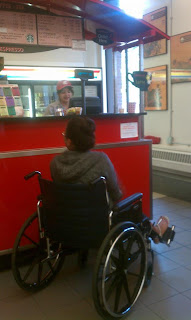As an opportunity to understand the difficulties of manuevering in a wheelchair, I was able to visit some places that I see everyday and view them from another perspective. What I found in most cases, was that although for the most part, the designs might have met ADA codes, they were still unrealistic and hard to operate in for a person in a wheelchair.
While in the wheelchair, I tried to reach into the bottom of the refrigerator and pull out a drawer. Although this might normally be considered and easy task, I was unable to pull out the drawer with ease because my chair was in the way. The only way to be able to reach the drawer would be to position myslef right next to the fridge, which put in directly in the way of the drawer. I would suggest higher drawers that are along the top portion of the refrigerator, making them more easy to reach.
While ordering my drink at the coffee bar that I usually visit everyday, I noticed that I was unable to reach the counter and was so low that I couldn't even see the baristas forehead. It was difficult ordering when unable to see her and because the counter was blocking my line of sight, it was also making so that she had a hard time hearing my order. Afterwards, I went to grab a napkin and had to have someone help me because I was unalbe to reach. The counter that the napkins were on was too deep and they were on a rack that was too tall. As an alternative, I would suggest lowering the condiments and napkins or even having them accessible in bins from the front so that they are not only reachable from the top.
In another bathroom stall, I expereinced the same problems as before, along with the difficulty that came with exiting the stall. The door was placed in an awkward spot in relation to the wall, which posed a problem for turning in the wheelchair. After much frustration, I was eventually able to exit the stall and the bathroom.
Another situation that I found very difficult was turning around in elevators. One elevator allowed enough room for me to turn around, however there was another in a seperate building that I could not fit in unless I turned the wheelchair. If there was, however, other people on the elevator, this would be nearly impossibly or at the very least, time-consuming.
Overall the experience taught me that in addition to simple ADA codes required for a space, practical clearances for wheelchair users need to be considered to allow them as much accessibility as possible. Having to use a wheelchair or any other walking aid is time-consuming enough, and poor design decisions only exacerbate that problem. We, as designers, have a duty to design for everyone and to make proper decisions that make live easier no matter a person's method of mobility.





